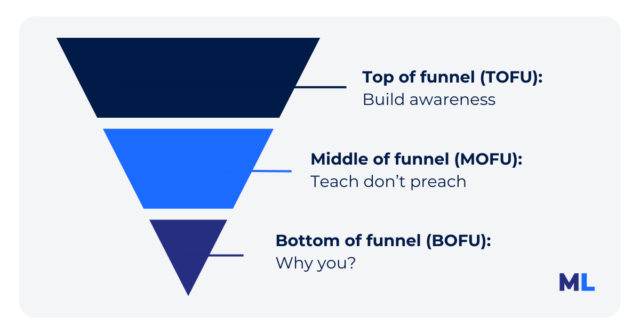
Unlock Global ABM at Scale — Madison Logic strengthens ABM reach with Connected TV and Audio expansion globally. Learn More
Unlock Global ABM at Scale — Madison Logic strengthens ABM reach with Connected TV and Audio expansion globally. Learn More

A common question among marketers is: What content is best at each stage of the buyer journey?
As account-based marketing (ABM) becomes more integrated into multi-channel strategies, understanding the right content and messaging for each stage is crucial. Tailoring your content to address the specific needs of prospects at different points in their journey helps build stronger connections and drives conversions.
But what really makes your content marketing strategy stand out? And how can you ensure your content captures attention, delivers value, and resonates with your target audience at every stage of their buying process?
Let’s dive into how to optimize your content across the funnel for maximum impact.
Content marketing is a strategic approach used by marketing professionals to attract, retain, and inspire a specific audience by delivering valuable and relevant content like relevant blogs, videos, podcasts, eBooks, social posts, and other media. This is achieved by creating and distributing content that solves problems for prospects and customers, meeting them where they are in their buying journey. Effective content marketing often incorporates search engine optimization (SEO) as a key tactic to ensure content reaches the right audience by improving visibility in search results.
A few key objectives of B2B content marketing are:
In today’s busy world, grabbing buyer attention is harder than ever. To stand out, you need to offer a variety of marketing content types, each designed to engage and inform your audience in different ways. Great content creation can take many forms, let’s look at the different types of content:
As you create your content, keep in mind content repurposing strategies. Transform your existing content into new formats, such as turning an eBook into a series of social media posts or repurposing a podcast episode into a TikTok clip. This strategy maximizes the value and reach of your content, making it ideal for use across different platforms and engaging a wider audience. Moreover, it ensures that your messaging remains clear and consistent across multiple channels and platforms.
Content marketing works best when your content focuses on meeting buyers right where they are in their buying stage progression. Identifying the best content for each stage of the funnel, whether it’s building awareness, nurturing leads, or driving conversions, is essential to creating content that resonates and drives impact.
An ABM content strategy takes this a step further by focusing on the entire buying group, ensuring the right content is in place to boost brand awareness and generate demand. To visualize this, we’ll break the funnel into three core stages:
Below, we’ll explore how to adapt your ABM content aligned with buyer intent data for each stage of the funnel, and the most effective content formats to use.

The goal at the top of the funnel is to ultimately attract customers and build awareness. At this stage, prospects are becoming aware of your brand, while searching for solutions for a challenge or problem they have. Your content should help them understand how to address and overcome those challenges effectively.
The key challenge here is making sure you attract the right prospects and customers. The solution lies in having a clearly defined Ideal Customer Profile and Target Account List to make sure you are targeting the right audience.
This is where account-based marketing becomes essential. With an ABM approach, this means crafting content that appeals to key decision-makers within your ideal accounts and ensuring it aligns with their industry-specific challenges and objectives. With the help of intent data, you can focus your content marketing efforts on the accounts that are actively researching solutions in your industry. This helps you identify accounts conducting research and the specific terms they’re searching for and create content that directly addresses those needs, ensuring it’s timely, relevant, and effective at capturing attention.

By using intent data, you can identify accounts conducting research and the specific terms they’re searching for. This helps create content that directly addresses those needs, ensuring it’s timely, relevant, and effective at capturing attention.
These intent signals might look something like:
With this insight in hand, you can create in-depth, long-form content and other resources that are hyper-relevant, positioning your brand as a trusted advisor to those early into the buying journey. Let’s look at some of the content that might be most effective in engaging TOFU buyers.
The middle of the funnel is all about informing and engaging prospects without aggressively promoting your brand. At this stage of the funnel, content shifts from building broad awareness to creating deeper connections and providing valuable insights and solutions tailored to prospect’s specific needs.
However, the middle of the funnel can be a challenging stage. Your leads are diverse, each looking to solve a unique problem and each at a different point in their buying journey. They’ve shown interest in your brand but aren’t quite ready to make a decision.
Here, an account-based approach provides the framework needed to overcome the complexity of the MOFU stage. With B2B solutions consisting of six to ten decision-makers, ABM provides insight into the roles and priorities of everyone involved in the decision-making process, enabling you to deliver more personalized buyer experiences that resonate with the entire buying committee. Additionally, ABM content syndication allows you to nurture key accounts by delivering relevant content at scale, ensuring your messaging reaches the right people at the right time, and guiding them through their buying journey. By tracking account-level activity, ABM tools can help tailor your content and messaging, ensuring that each decision-maker receives the most relevant information.

At the middle of the funnel, intent signals help you gauge where prospects are in their journey and how to engage them effectively.
These signals might look like:
By analyzing these signals, you can better understand where prospects are in their journey and tailor your content to meet their needs.
At this stage, the focus shifts to providing educational content that continues to address prospects’ challenges while gradually positioning your product as the ideal solution.
The most effective content formats include:
At the bottom of the funnel (BOFU), an account is nearly ready to make a final decision, it just needs to be persuaded that your product is the right solution. The main goal of the BOFU stage is to convert prospects into customers.
At this stage, your prospects are more inclined to speak with a sales representative. When this conversation happens, the sales rep should be equipped with insights gathered from the prospect’s behavior throughout the funnel. This includes:
Leveraging an ABM approach helps strengthen this process. Marketing helps track and capture the right signals, while sales teams can leverage this data to have more informed, relevant conversations with prospects. With this alignment, sales reps can use targeted content such as case studies, ROI calculators, or product demos to continue the conversation and reinforce the value of your solution. This content not only supports the sales rep’s efforts but also ensures the conversation is personalized, timely, and likely to result in a conversion.

As prospects near the bottom of the funnel, they’re showing clear signs of being ready to make a purchase decision.
These intent signals might look like:
By tracking these signals, you can identify when prospects are truly ready for a more direct sales conversation and tailor your outreach to meet their needs in this critical stage.
At this stage, content should directly support the decision-making process, focusing on reinforcing why your product is the best choice.
Effective BOFU content formats include:
As buyers’ preferences change, approaches will continue to shift, and your content will have to adapt. A recent survey from Madison Logic and The Harris Poll highlights key B2B marketing predictions and trends that are shaping the future of content marketing, uncovering how businesses will need to adjust their strategies across the funnel to stay ahead.
An AI ABM strategy can enhance your content marketing by enabling personalized, scalable engagement across the entire funnel. However, it’s crucial to maintain high-quality content by training AI on your brand’s voice and managing data integrity, as AI solutions often rely on large datasets.
Video marketing is a powerful tool for engaging prospects, easily shared across channels like social media, email, and connected TV. Tailoring videos for specific accounts or personas enhances ABM strategies, ensuring messages resonate with the right audience at the right time.
Social media platforms, including TikTok and Instagram, offer a powerful way to engage target accounts and build awareness, especially with younger millennial buyers. With personalized posts, videos, and targeted ads, social media can be leveraged in ABM strategies to connect with key prospects at the right moments in their journey.
Effectively reaching target accounts at every stage of the funnel requires smart ABM strategies. By aligning your content with the needs of each stage, you can drive engagement, spark interest, and ultimately guide prospects toward making a decision.
The ML Platform empowers marketers to track target accounts throughout the funnel with multi-channel activation. This allows you to surround all members of the buying group with tailored messaging to drive engagement and demand. Paired with Madison Logic’s market-leading intent data, ML Insights then helps you uncover the topics that speak to your audience, enabling you to create impactful content marketing campaigns that engage accounts at the right time.
Request a demo to learn more about how Madison Logic can help you to deliver the best content and messaging at every stage of the funnel.